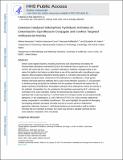| dc.contributor.author | Neumann, Wilma | |
| dc.contributor.author | Sassone-Corsi, Martina | |
| dc.contributor.author | Raffatellu, Manuela | |
| dc.contributor.author | Nolan, Elizabeth Marie | |
| dc.date.accessioned | 2020-01-23T20:43:15Z | |
| dc.date.available | 2020-01-23T20:43:15Z | |
| dc.date.issued | 2018-03 | |
| dc.date.submitted | 2018-01 | |
| dc.identifier.issn | 0002-7863 | |
| dc.identifier.issn | 1520-5126 | |
| dc.identifier.uri | https://hdl.handle.net/1721.1/123660 | |
| dc.description.abstract | Enteric Gram-negative bacteria, including Escherichia coli, biosynthesize and deploy the triscatecholate siderophore enterobactin (Ent) in the vertebrate host to acquire iron, an essential nutrient. We report that Ent-Cipro, a synthetic siderophore-antibiotic conjugate based on the native Ent platform that harbors an alkyl linker at one of the catechols with a ciprofloxacin cargo attached, affords targeted antibacterial activity against E. coli strains that express the pathogen-associated iroA gene cluster. Attachment of the siderophore to ciprofloxacin, a DNA gyrase inhibitor and broad-spectrum antibiotic that is used to treat infections caused by E. coli, generates an inactive prodrug and guides the antibiotic into the cytoplasm of bacteria that express the Ent uptake machinery (FepABCDG). Intracellular hydrolysis of the siderophore restores the activity of the antibiotic. Remarkably, Fes, the cytoplasmic Ent hydrolase expressed by all E. coli, does not contribute to Ent-Cipro activation. Instead, this processing step requires IroD, a cytoplasmic hydrolase that is expressed only by E. coli that harbor the iroA gene cluster and are predominantly pathogenic. In the uropathogenic E. coli UTI89 and CFT073, Ent-Cipro provides antibacterial activity comparable to unmodified ciprofloxacin. This work highlights the potential of leveraging and targeting pathogen-associated microbial enzymes in narrow-spectrum antibacterial approaches. Moreover, because E. coli include harmless gut commensals as well as resident microbes that can contribute to disease, Ent-Cipro may provide a valuable chemical tool for strain-selective modulation of the microbiota. Keywords: iron; antimicrobial agents; genetics; antibacterial activity; conjugate acid-base pairs | en_US |
| dc.description.sponsorship | National Institutes of Health (U.S.) (Grant 1R21AI126465) | en_US |
| dc.description.sponsorship | National Institutes of Health (U.S.) (Grant 1R01AI114625) | en_US |
| dc.language.iso | en | |
| dc.publisher | American Chemical Society (ACS) | en_US |
| dc.relation.isversionof | http://dx.doi.org/10.1021/jacs.8b01042 | en_US |
| dc.rights | Article is made available in accordance with the publisher's policy and may be subject to US copyright law. Please refer to the publisher's site for terms of use. | en_US |
| dc.source | PMC | en_US |
| dc.title | Esterase-Catalyzed Siderophore Hydrolysis Activates an Enterobactin–Ciprofloxacin Conjugate and Confers Targeted Antibacterial Activity | en_US |
| dc.type | Article | en_US |
| dc.identifier.citation | Neumann, Wilma et al. "Esterase-Catalyzed Siderophore Hydrolysis Activates an Enterobactin–Ciprofloxacin Conjugate and Confers Targeted Antibacterial Activity." Journal of the American Chemical Society 140, 15 (March 2018): 5193-5201 © 2018 American Chemical Society | en_US |
| dc.contributor.department | Massachusetts Institute of Technology. Department of Chemistry | en_US |
| dc.relation.journal | Journal of the American Chemical Society | en_US |
| dc.eprint.version | Author's final manuscript | en_US |
| dc.type.uri | http://purl.org/eprint/type/JournalArticle | en_US |
| eprint.status | http://purl.org/eprint/status/PeerReviewed | en_US |
| dc.date.updated | 2020-01-02T17:10:24Z | |
| dspace.date.submission | 2020-01-02T17:10:26Z | |
| mit.journal.volume | 140 | en_US |
| mit.journal.issue | 15 | en_US |
| mit.metadata.status | Complete | |
